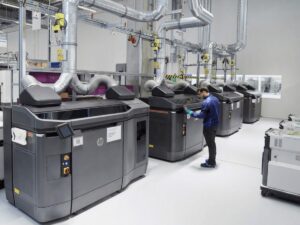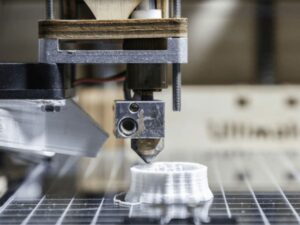Fascinated by China’s rise as a global manufacturing giant? Much of this is attributed to their proficiency in 3D printing services. Traditional manufacturing processes, often slow and resource-heavy, struggle with complex designs. However, the emergence of 3D printing technology presents a swift, flexible, and cost-effective solution, revolutionizing the manufacturing landscape.
In this article, we delve into the intricacies of the 3D printing service industry in China, shedding light on its workings, advantages, and challenges. Now, this is important: for entrepreneurs looking to harness these services, this is a must-read. We offer you a thorough understanding of the potential, along with the risks and rewards that come with it.
Without further delay, let’s embark on this enlightening journey! There is a world of opportunities waiting for you to discover.
1. Overview of 3D Printing Services in China
China’s 3D printing industry is reshaping the way products are designed, prototyped, and manufactured. This transformative technology opens up new possibilities for customization, speed, and affordability, giving businesses a competitive edge in today’s dynamic market. Here’s why that’s important: embracing China’s 3D printing industry means staying ahead of the curve and unlocking a world of opportunities for your business.
As businesses and industries recognize the benefits and potential of 3D printing, the market continues to thrive, offering exciting opportunities for manufacturers and entrepreneurs alike. And the best part is, China’s 3D printing industry is not only embracing this transformative technology, but it’s also leading the way in its adoption and advancements.
2. The Evolution of 3D Printing
The Evolution of 3D Printing refers to the gradual development and advancements of 3D printing technology over time. It encompasses the origin of the concept, the expansion of its applications, and the present state as well as the future potential. The following are the different subsections that delve into the specific aspects of the evolution of 3D printing:
Origin
3D printing, or additive manufacturing, emerged in the 1980s. Yet, it gained significant momentum in the early 2000s as key patents expired, allowing broader innovation and accessibility. Here’s the interesting part… In the early 2000s, as patents on essential technologies expired and innovation became more accessible, 3D printing began to gain traction. This sparked advancements and opened up endless possibilities in the field.
Expansion
As technology advanced, so did 3D printing, capturing the attention of companies for prototyping and small-scale production. Its adoption in the manufacturing industry is on the rise. According to Grand View Research, the 3D printing market worldwide reached a valuation of USD 16.75 billion in 2022 and is anticipated to exhibit a steady compound annual growth rate (CAGR) of 23.3% from 2023 to 2030.
Present and Future
Today, advancements in technology and materials are driving the growth of 3D printing. Its uses have expanded to various industries like healthcare, aerospace, and automotive. But you must be wondering… what lies ahead? Well, the future is even more promising with advancements in metal and multi-material printing. These developments enhance aerospace performance, design complexity, and functionality.
3. Benefits of Using Chinese 3D Printing Services
Chinese 3D printing services have gained recognition for their unique strengths and capabilities in the global market. We will delve into the advantages, examples, and applications associated with these key benefits of utilizing Chinese 3D printing services that are presented below:
Cost-Effectiveness
Chinese 3D printing services provide cost-effective solutions, thanks to the country’s manufacturing capabilities and competitive pricing. For example, leveraging Chinese 3D printing services can reduce production costs by up to 50%. This cost advantage enables businesses to allocate resources more efficiently and invest in other critical areas.
Rapid Prototyping
One of the key advantages of Chinese 3D printing services is rapid prototyping. Businesses can quickly transform their designs into tangible prototypes, allowing for faster iterations and reducing time to market. I’m sure you’re with me on this one; time is of the essence in today’s dynamic business landscape. This speed can be crucial in gaining a competitive edge and responding to market demands promptly.
Production Quality
Chinese 3D printing services offer exceptional production quality, delivering precise and reliable components. With advancements in technology and expertise, these services can meet the high-quality standards required by various industries. I think you’ll agree with me when I say… The use of advanced materials and stringent quality control measures is vital to ensure that the end products meet or even surpass expectations.
4. 4 Types of 3D Printing Technologies
The 4 Types of 3D Printing Technologies refer to the different methods and processes used to create three-dimensional objects through additive manufacturing. Outlined below are the different subsections that explore each type of 3D printing technology:
Fused Deposition Modeling (FDM)
FDM is a widely used 3D printing technology that works by extruding melted thermoplastic materials layer by layer. It offers material versatility and is ideal for prototypes and low-cost production. For instance, FDM is commonly used in creating durable and cost-effective tooling for manufacturing processes. With FDM, it makes durable and cost-effective tooling that meets production demands and optimizes costs.
Stereolithography (SLA)
SLA uses a UV laser to solidify liquid photopolymer resin layer by layer, resulting in highly detailed and precise prints.SLA is ideal for intricate, high-resolution prototypes and models, setting it apart with exceptional detail. You don’t want to miss this next part, as SLA plays a crucial role in advancing medical procedures and improving patient outcomes through its high precision and accuracy.
Selective Laser Sintering (SLS)
SLS utilizes a high-powered laser to selectively fuse powdered materials, such as nylon or metal, layer by layer. This technology excels in creating functional prototypes and end-use parts with exceptional mechanical properties. It all boils down to this: when it comes to manufacturing intricate parts that can withstand rigorous demands, SLS is the go-to solution.
Digital Light Processing (DLP)
DLP, or Digital Light Processing, utilizes projected light to cure liquid photopolymer resin into solid layers, offering both high printing speed and precision. Its capabilities make it an excellent choice for intricate designs and small-scale production. The combination of speed and accuracy provided by DLP makes it a compelling option for businesses seeking efficient and precise 3D printing solutions.
5. Key Applications and Industries
This section refers to the specific areas and sectors where 3D printing technology is extensively utilized to create innovative solutions and products. Here is a list of key applications and industries where 3D printing has made significant advancements, transforming the way products are designed, manufactured, and utilized in various sectors:
Automotive Industry
The automotive industry has embraced 3D printing for prototyping, functional parts, and tooling. It enables rapid iteration and cost-effective production. So what’s my point? 3D printing has revolutionized the automotive design and manufacturing processes, as companies can leverage this technology to create lightweight and complex components, thereby enhancing fuel efficiency and performance.
Medical Industry
In medicine, 3D printing transforms patient care, customization, and surgical planning by creating patient-specific anatomical models, prosthetics, implants, and surgical guides. According to GlobeNewswire, the projected compound annual growth rate (CAGR) for the 3D printing medical devices market is 17.1%, and it is expected to increase from USD 2.7 billion in 2022 to USD 6.9 billion by 2028.
Aerospace Industry
Aerospace manufacturers utilize 3D printing to create lightweight, intricate components and facilitate rapid prototyping, achieving high performance with reduced weight. Now, this is important… The application of 3D printing on jet engine components leads to enhanced fuel efficiency and reduced emissions. 3D printing drives remarkable advancements in aerospace, pushing design and manufacturing boundaries in aviation.
6. Challenges Faced by 3D Printing Services in China
Challenges can impact different aspects of the 3D printing process, from intellectual property rights to technological limitations, quality control, and material selection. The provided below will delve into each of these challenges in detail, providing insights into the specific issues faced by 3D printing services in China:
Intellectual Property Rights
Protecting intellectual property, such as designs, from unauthorized duplication is crucial in the 3D printing industry to foster innovation and maintain market integrity. Suprotos ensures stringent measures to protect intellectual property and maintain confidentiality during the 3D printing process, serving as a trusted partner for businesses.
Technological Limitations
Although 3D printing has advanced significantly, there are still technological limitations. Improvements in print speed, size restrictions, and material capabilities are necessary to meet diverse customer demands effectively. And now, you’re thinking…To unlock the full potential of 3D printing, we invest in research and development, overcoming limitations and driving innovation in manufacturing and design.
Quality Control and Standardization
Ensuring consistent quality and adhering to industry standards is essential for the widespread adoption of 3D printing. Suprotos takes a leading role in this pursuit. Our focus is on maintaining stringent quality standards that set us apart as a trusted partner, providing businesses with the assurance of excellence and ensuring customer satisfaction.
Material Selection and Sustainability
With sustainability in focus, 3D printing services face the challenge of balancing material performance and environmental responsibility. This delicate balance is crucial for the long-term viability of the industry. I can almost hear you thinking… How do companies achieve this? Developing eco-friendly solutions while maintaining the quality and functionality of printed products requires continuous research and innovation.
7. 5 Factors To Consider When Choosing a 3D Printing Service in China
Entrepreneurs and business owners should evaluate when selecting a service provider for their 3D printing needs. Here are the following that will provide detailed information on each of these factors, helping readers navigate the selection process and choose the most suitable service provider for their specific needs:
#1 Quality Assurance and Certifications
When selecting a 3D printing service provider, prioritize robust quality assurance processes and relevant certifications to ensure the excellence, quality, and reliability of your printed products. Suprotos, a leading brand in the industry, prioritizes quality and holds certifications that demonstrate their commitment to delivering reliable and high-quality 3D printed products.
#2 Pricing Models and Cost-Effectiveness
When choosing a 3D printing service, carefully assess their pricing models to ensure cost-effectiveness without compromising quality. For example, some 3D printing service providers offer tiered pricing models based on the complexity or size of the project. This enables your business to select a pricing option that aligns with your budget and maintains the desired quality standards.
The table provides an overview of different pricing models for 3D printing services, highlighting their descriptions and cost-effectiveness considerations to help businesses make informed decisions.
| Pricing Model |
Description |
Cost-Effectiveness |
| Flat Rate |
The service provider charges a fixed rate for 3D printing services, regardless of the complexity or size of the project. |
This model can be cost-effective for simple and small projects, but may become expensive for larger and more intricate designs. |
| Tiered Pricing |
The pricing is divided into different tiers based on the complexity or size of the project. Each tier has a specific cost associated with it. |
Tiered pricing allows businesses to choose a cost-effective option that aligns with their project requirements and budget. |
| Volume-Based Pricing |
The cost is determined by the volume of material used or the number of units printed. |
This model can be cost-effective for businesses that require larger quantities or regularly recurring orders. |
| Time-Based Pricing |
The pricing is based on the time taken to complete the 3D printing job, including setup, printing, and post-processing. |
Time-based pricing can be cost-effective for projects that require minimal material usage or involve short printing times. |
| Material-Based Pricing |
The cost is calculated based on the type and quantity of material used in the printing process. |
Material-based pricing is beneficial when working with expensive or specialized materials, allowing cost control and optimization. |
| Custom Quote |
The service provider assesses the project requirements and provides a customized quote based on specific factors such as design complexity, finishing options, etc. |
This model offers flexibility and allows for negotiation to achieve the desired cost-effectiveness for unique or complex projects. |
| Membership/Subscription |
Businesses can opt for a recurring membership or subscription plan, providing access to discounted rates or additional benefits. |
Membership or subscription plans can be cost-effective for businesses with frequent or ongoing 3D printing needs. |
#3 Turnaround Time and Production Capacity
When choosing a service provider, assess their turnaround time and production capacity to meet deadlines and handle varying volumes. By considering these factors, you won’t believe what we discovered – you can choose a reliable partner who can deliver your 3D printing projects in a timely manner while accommodating your specific production needs.
#4 Customer Support and Communication Channels
Effective customer support and clear communication channels are vital for a seamless collaboration experience. Then it finally dawned on me: time responses and transparent communication play a crucial role in fostering a successful partnership. Reliable customer support and open communication ensure smooth collaboration and project progress.
#5 Feedback and Reviews from Previous Clients
Consider feedback and reviews from previous clients to gain insights into the service provider’s reputation, reliability, and customer satisfaction levels. Their experiences can provide valuable information that helps make an informed decision about the service provider’s performance and the quality of their 3D printing services. Evaluating feedback helps make informed choices aligned with your expectations.
Dive Deeper Into Our Resources
Looking for more diverse service options? Browse through our handpicked selections:
For some insightful reads, we’ve curated a list of recommended articles just for you:
Still haven’t found what you’re looking for? Don’t hesitate to contact us. We’re available around the clock to assist you.
Conclusion
In conclusion, the advancements brought by In-Mold Labeling (IML) in product packaging are remarkable. The technique seamlessly combines aesthetics with functionality, providing businesses with a competitive edge in a visually-driven marketplace. Here’s the catch: the technique seamlessly combines aesthetics with functionality, providing businesses with a competitive edge in a visually-driven marketplace.
To leverage the benefits of IML and enhance your product packaging game, partner with Suprotos, our trusted CNC machining manufacturer. Contact us today to explore the possibilities and unlock the full potential of In-Mold Labeling.






